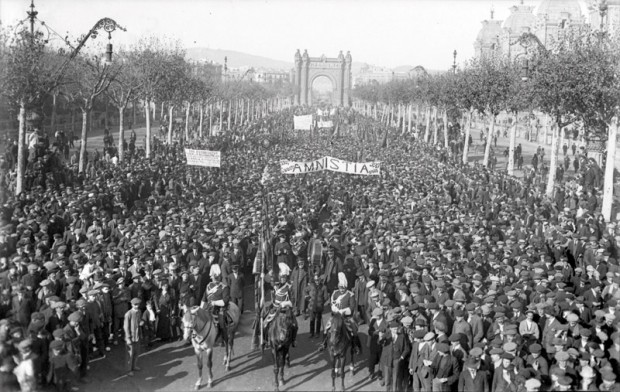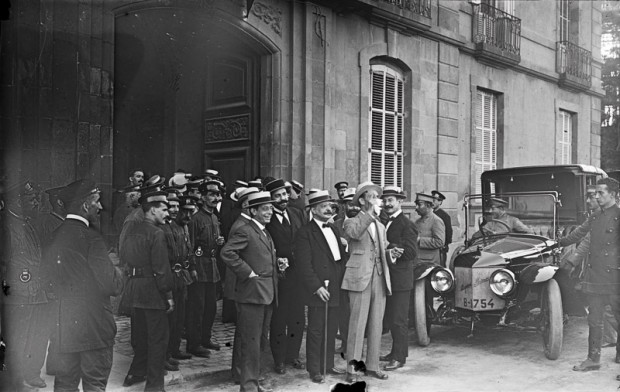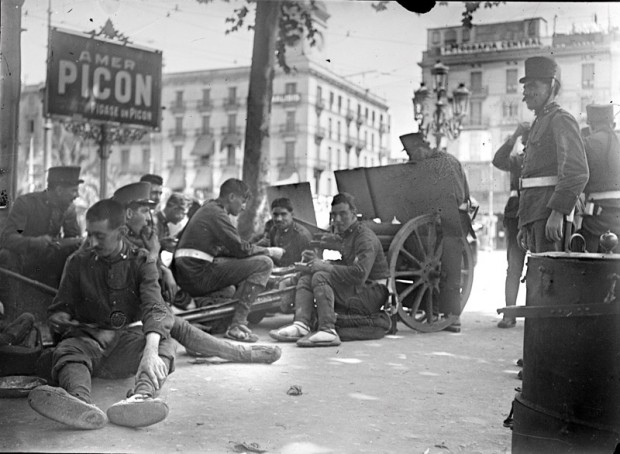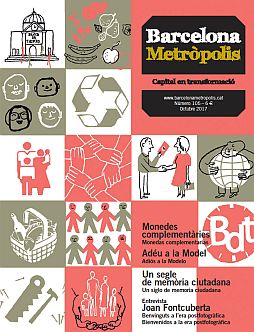
Demonstration in today’s Passeig de Lluís Companys, then Saló de Sant Joan, on 2 December 1917, in demand of an amnesty for political and social prisoners and the reinstatement of workers laid off during the general strike in August.
Photo: Brangulí / Arxiu Nacional de Catalunya
In the midst of a major political and social crisis, the CNT and UGT trade unions, supported by the PSOE and the republican parties, called a revolutionary general strike in the summer of 1917. The Russian Revolution was well underway and it raised hopes that were unrealistically optimistic.
One of the books that I have treasured the most since I was a boy is Tintin in the Land of the Soviets, a jewel of a book originally published between 1929 and 1930 in the Belgian weekly Le Petit Vingtième. It’s been said that it was purposely commissioned by Le Vingtième Siècle, a conservative, Catholic and nationalist newspaper, to spread anti-communist propaganda during Josef Stalin’s leadership. And thus it was that Hergé dispatched Tintin and Snowy the dog to the hypothetical homeland of socialism to unmask its policies and reveal the secrets of a contradictory regime that would do whatever it took to get them out of the way. As always, Tintin, the journalist who never wrote, a mix of Indiana Jones and Sherlock Holmes, returned home a hero. An ideological metaphor rooted in the interwar period.
This was one of my first experiences of Russia and it was followed by a long and weighty list of icons, public dangers, clichés and references, including the revolution, the centenary of which is commemorated this year and the reason I write this article. To be precise, I am writing about its effects on Spain, on Catalonia and on Barcelona. But we need a bit of background…
Let’s go back to Barcelona, “the rose of fire”, shortly after the Tragic Week. The First World War is well underway and a neutral Spain is watching its Empire crumble. The Catalan government, known as the Mancomunitat, is governed by the Catalan nationalist Prat de la Riba. And the anarcho-syndicalist CNT is always just around the corner. The first taxi and city bus services are up and running… hotly disputed by the tram companies. The economy is on a downturn, there are redundancies, workers’ movements are boiling over and the Bourbon Restoration is hanging by a thread. Latent instability and social unrest. Soon after, in a Russia brought to its knees by famine and inflation, the revolt against Nicholas II breaks out.
The land that Tintin discovered, or a somewhat distorted image of it, is unimaginable without the Russian Revolution, but one must bear in mind that a decade has gone by and that it is no longer Lenin, but Stalin, who governs; that Trotsky has been sent into exile; and the Bolshevik regime is beginning to introduce its Five Year Plans. In Spain, the ‘soft dictatorship’ is limping to its end, ready to pass the baton to the Second Republic and to draw a line under the Bourbon regimes once and for all. But the Bourbon Restoration system had already been in crisis for some time and it was against the background of the Russian Revolution that Spain’s Alfonso XIII saw the ground under his feet start to shudder alarmingly.
Political obsolescence
In 1917, military and political unrest was more intense than ever, and it was developing alongside workers’ movement protests and the demands of certain parties that wanted to modernise the monarchy, such as the Lliga Regionalista led by Francesc Cambó, which demanded autonomy for Catalonia, constitutional reform and the conversion of the Catalan Corts into a constituent body within a federal state. Despite the economic barriers, the bourgeoisie was able to profit from Spanish neutrality during the Great War, as it was good for exports. But the social reality of the country was very different, with growing poverty in stark contrast to the opulence of the well-to-do classes. While some people saw their wealth increase, the class consciousness of others became stronger. And in turn, a section of the Army decided to rise up against the arbitrary hierarchical divisions inside the organisation.

The second meeting of the Assemblea de Parlamentaris took place in 1917 in La Ciutadella. The 68 members of parliament taking part demanded a constitutional assembly to undertake a reform of the regime.
Photo: Josep M. Sagarra i Plana / Arxiu Nacional de Catalunya
According to historian José Luis Martín Ramos, there was a serious political crisis in 1917, even though the largest opposition groups advocated “reforming the system from within, or replacing it with another system, but not with a social revolution”. Reform, but not a violent lurch. At this point, the Lliga and the Catalan nationalist movement see their chance and, with reform as their excuse, aspire to play their part in governing Spain, to having more power in a country where political divisions are deepened by the disruptive presence of supporters of the Allies and of germanophiles. Even the King was a germanophile, while some of his ministers supported the Allies. José Luis Martín Ramos, a researcher at the Department of Modern and Contemporary History at UAB, took part in a seminar in June at MUHBA (The Museum of the History of Barcelona) on “Crises and revolutions in Barcelona, 1917”, where he summarised the situation in terms of political obsolescence. Everything pointed to the fact that that society was reaching a crossroads and was very likely to take a completely different path.
In this turbulent environment, Alfonso XIII was having to face attacks on three fronts: the military front, which culminated in the famous conflict of the Juntas de Defensa (internal strife at the top of the military hierarchy); the political front, which led to the controversial Assemblea de Parlamentaris (an unofficial Assembly of Parliamentarians); and the social front, the most troublesome of all, headed by an ever stronger workers’ movement that aligned itself with republicanism and was starting to get involved in politics. Three ideas of change from three very different places. When news came of the events in Russia, revolution in Spain seemed inevitable. The only apparent problem was the lack of consensus, which would be a key factor in depleting its strength.
Unlikely bedfellows
After the twenty-four hour strike organised in December 1916, the CNT and the UGT joined forces again with the aim of bringing the country to a standstill for over a day, and they immediately won the support of the PSOE and the republican parties. The strike obviously had another dimension to it, projected by the hope that the Army would take the side of the protestors, as had occurred in Russia. But the Army, just like the politicians, turned their back on the demonstrators. And not just that, but it also strongly supressed the protests. The explanation was simple – the dissident officers had succeeded in getting the King to listen to them. From then on, their political commitment or their desire for regime change was nothing more than an abstraction, and there was not much to tie them to the protests held by the workers’ movements and the anarchists.
The lack of support from political groups was understandable, if we bear in mind the ambitions they each had. Seeing Cambó and the CNT joining forces was about as unlikely as an alliance between the separatist left-wing CUP and the conservative former Convergència is today. And although the latter has actually come to pass, the former hypothesis never did. The leader of the Lliga was never accepted by the Juntas de Defensa military group, which cut short any possible alliance in the parliamentary struggles. The three pillars of the political crisis collapsed. The strike, then, served to highlight the lack of any common ground between the protesters, the political parties and the trade unions, and to shatter the homogeneity of the Assemblea de Parlamentaris. Once it was over, the CNT and the UGT distanced themselves from each other even more. The Army once again lent its support to the official regime and the republican parties, now in cahoots with the bourgeoisie, did the same. Political pragmatism: as promiscuous and flighty as always.
The strike and the whys and wherefores of the failed revolution of 1917
Barcelona came to a stop for five days, from 13 to 18 August. Despite the general and ideological failure of the protest, the government imposed martial law and violence was exerted on many sectors of an angry population that soon after came to be known as “pistol city”. It could have been twinned with Al Capone’s Chicago. The strike ended with thirty-two dead, around sixty injured and one hundred and eighty people arrested. A tragedy that could have been worse, but the uprising turned out to be shorter and less significant than expected. Too much revolutionary expectation had been placed on it, fired up by the events in Russia, where the Bolsheviks were about to seize power. Another major disadvantage compared to the Russian context was the absence of intellectuals supporting the revolutionaries. In all the other cities across Spain where there were big public movements like this, the result was no different. The general strike had missed the mark. But the social conflict did not go away.

Troops in the street during the strike at La Canadenca in 1919, a successful social movement, unlike the strike of 1917.
Photo: Josep M. Sagarra i Plana / Arxiu Nacional de Catalunya
One proof of this, aside from pistolerismo (the practice of hiring thugs and gunmen for political assassinations), was the La Canadenca strike of 1919. And one could reasonably ask: why was this strike successful when that of 1917 failed? The historian Pelai Pagès, who also took part in the seminar at MUHBA, attributes it to various factors, starting with the lack of coordination between the CNT and UGT (whereas the La Canadenca strike was only called by the CNT, which had created the sole trade union a few months previously). “It was too hurried and that was the fault of the government”, says Pagès. The lack of collaboration with the Army and the political parties slowed down the revolutionary momentum. In addition, in 1919 the effects of the end of the First World War were still being felt – a totally different scenario to 1917. And lastly, the key issue: behind the La Canadenca strike “there was a crucial demand aside from the general social malaise”: the eight hour working day. And in this sense, it was a success.
During the course of those years, the incompetence of leaders was laid bare, as was the resulting exhaustion of a regime incapable of meeting the challenges of the time. There was general discontent, but in 1923, General Primo de Rivera suspended the Constitution and established a dictatorship that lasted until 1929.



